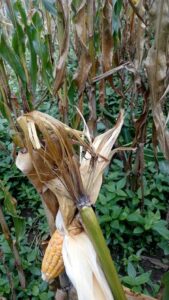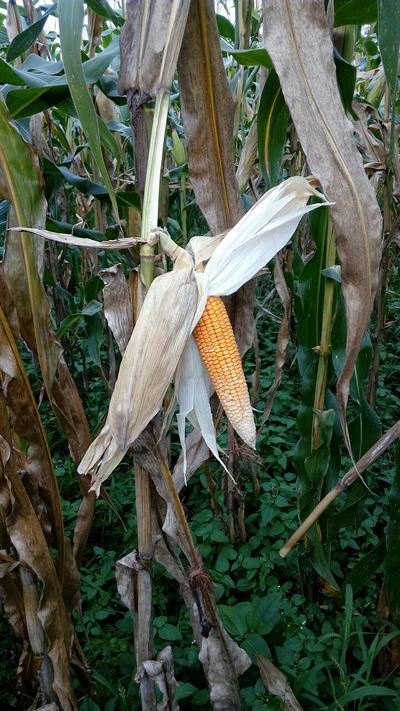Maize, a staple crop in India and Bangladesh, faces significant challenges due to stalk rots caused by various fungi and bacteria during the near-maturity stage. The impact of stalk rots can result in substantial losses ranging from 10% to 20%. These losses are attributed to poor cob filling and lodging of affected plants. In this comprehensive guide, we will delve into the bacterial and fungal pathogens associated with maize stalk rot, symptoms, major contributors to the rot complex, disease cycle, and effective control measures for optimal crop management.

Bacterial Pathogens:
- 1. Pseudomonas avenae sub-sp. avenae:
– Description: This bacterium contributes to stalk rot, affecting the plant’s maturity.
– Impact: Causes poor cob filling and increases the risk of lodging. - 2. Enterobacter dissolvens (Erwinia dissolvens):
– Description: Identified as a bacterial pathogen, it poses a threat to maize plants.
– Impact: Contributes to losses in crop yield due to its association with stalk rot. - 3. Erwinia carotovora sub-sp. carotovora:
– Description: Also known as chrysanthemi pv. Zae, it is linked to maize stalk rot.
– Impact: Results in compromised cob filling and plant lodging, leading to yield losses.

Fungal Pathogens:
- 1. Colletotrichum graminicola (Telemorph: Glomerella graminicola):
– Description: Fungal pathogen causing stalk rot with implications for crop yield.
– Impact: Affects internodes, leading to a grey appearance and potential lodging. - 2. Physoderma maydis:
– Description: Fungal pathogen contributing to maize stalk rot.
– Impact: Premature dying of lower leaves and a softening of internodes. - 3. Diplodia maydis:
– Description: Identified as a fungal pathogen causing maize stalk rot.
– Impact: Leads to the rotting of pith and potential lodging. - 4. Fusarium moniliforme var. subglutinans:
– Description: Fungal pathogen associated with stalk rot in maize.
– Impact: Affects plant health, potentially leading to lodging. - 5. Gibberella zeae (Anamorph: Fusarium graminearum):
– Description: Dominant fungus in the rot complex, producing mycotoxins.
– Impact: Mycotoxins pose a threat to human and animal health. - 6. Setophaeria turcica (Anamorph: Exserohilum turcicum):
– Description: Fungal pathogen contributing to maize stalk rot.
– Impact: Associated with ear rot, affecting the development of ears. - 7. Pythium aphanidermatum:
– Description: Oomycete causing maize stalk rot.
– Impact: Infection leads to compromised plant health and potential lodging.
Symptoms:
Maize stalk rot manifests in two crucial phases – stalk rot and ear rot.
- 1. Stalk Rot Symptoms:
– Premature dying of lower leaves.
– Dull grey appearance.
– Softened internodes, tan to brown externally, and pink or reddish inside.
– Rotten pith, increasing the risk of lodging.
– Potential plant death if harvesting is delayed. - 2. Ear Rot Symptoms:
– Incomplete development of ears.
– Presence of pinkish mold between ear and husks.
Major Pathogens in the Rot Complex:
Gibberella zeae, Diplodia zeae, Fusarium species, and Colletotrichum graminicola are key contributors to the maize rot complex. G. zeae, in particular, dominates, producing ascospores, mycelium, and chlamydospores in infected plant debris. The fungus’s mycotoxins pose health risks to humans and animals.
Disease Cycle:
The pathogens persist in the soil from one growing season to the next, with wind-blown spores entering the leaf sheath base, causing infections. Insects, such as stem borers, may create wounds facilitating pathogen entry. Conidia on infected plant parts serve as secondary inoculum. Wet weather, especially near or after silking, favors disease development. Factors like high plant density, excess nitrogen, low potash doses, and early hybrid maturity also contribute to disease prevalence.
Control Measures:
Effective disease management is crucial for optimizing maize crop yield. Implement the following preventive measures:
- 1. Use Resistant Varieties:
– Opt for maize varieties resistant to stalk rot pathogens. - 2. Low Plant Density:
– Maintain an appropriate plant density to reduce disease spread. - 3. Proper Fertility Practices:
– Adopt balanced fertility practices, ensuring adequate nutrients without promoting disease. - 4. Insect Control:
– Implement insect control measures, especially against stem borers. - 5. Timely Harvesting:
– Harvest maize crops promptly to minimize the risk of disease spread.
Chemical Control:
Consider an integrated approach, combining preventive measures with biological treatments. Recommended chemical interventions include:
- Chlorination: Treat irrigation water or soil with bleaching powder (33% chlorine @ 10 kg/ha) during the pre-flowering stage.
- Copper Oxychloride Formulations: Effectively apply formulations containing copper oxychloride to combat the disease.
- Muriate of Potash (MOP): Addition of 80 kg/ha of MOP in two splits can reduce symptom severity.
Conclusion:
Maize stalk rots pose a significant threat to crop yield in India and Bangladesh. Understanding the pathogens, symptoms, and disease cycle is essential for effective management. By incorporating resistant varieties, maintaining proper plant density, practicing balanced fertility, controlling insects, and ensuring timely harvesting, farmers can mitigate the impact of stalk rots and enhance overall maize productivity. This comprehensive guide serves as a valuable resource for agricultural professionals seeking to optimize maize cultivation in the region.




